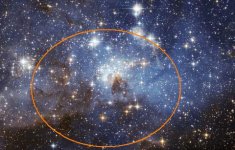lamar
Bronze Member
- Aug 30, 2004
- 1,341
- 46
Dear Shortstack;Shortstack said:lamar said:Dear Shortstack;Shortstack said:PULLLLease, Mr. lamar. I am well aware of the HOH situation. MY question concerns WHERE the element, oxygen came from originally. That BBang created only hydrogen and helium. According to the Banger scientists.
And on that evolving life thing, you so lightly skipped by, exactly HOW did the spark of life start from rocks and rain? But, lets not go there just yet. We still can't agree on how the universe was created.
And I'm waiting to hear how you think those Peruvian coloring books got up to our southwest Indians and to the European cave folks.
Oxygen comes from Helium my friend. Oxygen-16 synthesised towards the tail end of the helium fusion process in stars and Oxygen-17 comes from the CNO process whereby hydrgen and and helium are burned, making it one of the most common elements in the hydrogen furnace zones of most Oxygen class stars.
Your friend;
LAMAR
Mr. lamar, I apologize for taking so long to reply. I was busy sensitizing something from a pot of coffee.
Now, you brought back the fusion processes within a star as the manufacturing element of.....well, the elements. That brings us full circle back to the original discussion of how stars were formed. Yes, stars are amazing objects that were created when the universe was manufactured.Again, those pesky gas clouds just did not condense on their own. In a Big Bang, those energy particles would have been expelled out in straight trajectories with diverging paths; NOT converging. Thus, none would have been placed into a position to collide collaterally with another particle to induce "spins" in those particles.
Seems like I've mentioned these points before, but they were lightly glossed over. Ignoring them will not change their significance.
No apologies are necessary my friend. Continuing on:
Yes, it would seem that gas clouds do condense on their own, my friend. We can observe the Heavens and even through my pathetically inadaquate telescope I am able to view galaxies known as super clusters. One law is that all matter tends to *clump* together to form ever larger formations. For examples, atoms make up our Sun, which is a star, and enough stars make up a galaxy, and enough galxaies form into clusters and enough clusters form into super clusters. This is undeniably factual and we can observe this occurence on any given cloud-free night.
We also know that all matter has mass, or weight. This is true throughout our known Universe. Do you agree to this, my friend? If this is true, then all the individual atoms inside of a gas cloud also would have a mass. Do you also agree to this? Therefore, if all the atoms in a gas cloud had a mass, and if each one of those tiny atoms imparted an ever so slight amount of gravity, then eventually all the atoms would interact with their neighbors. This must be true, or else our moon would not orbit our planet and our planet would not be in orbit around our Sun. Do you agree to this, my friend?
In other words, every atom would start to orbit about it's neighboring atom. And then these two orbitial atoms would then attract other atoms until we now have an ever increasing mass (weight). Over time, the mass would continue increasing. Do you agree to this concept? As the mass increases, it also starts to contract, very slowly at first, then faster as the mass density increases. Eventually it reaches a point where thermonuclear fusion occurs and energy is then released.
Your friend;
LAMAR








 You know the stego shown in the photo is a modern rendering just as I do. Shoot, even the adobe is fresh looking! It hasn't even been fired! I could make the exact same thing in the morning, except with more details. LOL.
You know the stego shown in the photo is a modern rendering just as I do. Shoot, even the adobe is fresh looking! It hasn't even been fired! I could make the exact same thing in the morning, except with more details. LOL.
 I mean after all, you may know where YOU are, but does that mean I know where I am?
I mean after all, you may know where YOU are, but does that mean I know where I am? 




